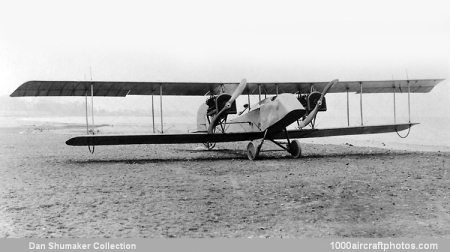The need for increased tail area was met by installing a Curtiss R-4 rudder and an enlarged fin on the prototype and a modified R-4 fin on the production versions. Directional control was still marginal but was improved somewhat by modifying the starboard 90 hp Curtiss OXX-2 engine to rotate in the opposite direction to that in the port side unit as was done on earlier Curtiss twin-engined flying boats.
The production Twin JNs reconnaissance aircraft (see 3-view) differed greatly in detail from the pictured prototype. The engines were fitted with radial radiators, an nose wheel was additionally fitted and the straight cabane struts were replaced by inverted V-shape ones.In spite of the two engines, the Twin JN was still only a two-seat machine and crew efficiency was greatly handicapped by the wide separation between the pilot's cockpit aft of the wing and the observer in the nose.
The USASC acquired eight Twin JNs (serial 102 to 107, 428, 470, delivery of 470 doubtful) in 1916 and early 1917, seven by direct purchase and one a donation to the Militia by private citizens. These saw very brief service on the Mexican border in 1916. The USN acquired two examples (serial A-93,
A-198), which were operated as twin-float seaplanes.
One Army model, serial number 428, differed greatly from the other Twin JNs. It was so retrograde in both aerodynamic and structural detail that in the absence of other evidence it is believed to be an entirely different and somewhat earlier aeroplane, possibly the rumored 'Twin R'. Since its general configuration was similar to the Twin JN, Curtiss doubtless found it easier to sell this existing aeroplane to the Army as a modified Twin JN than as a new and entirely separate design.
